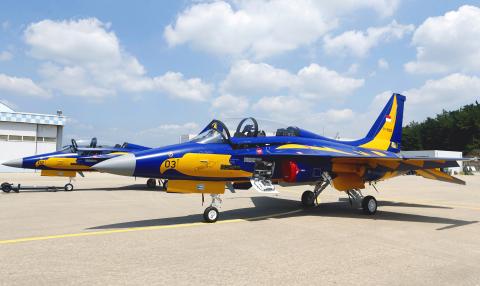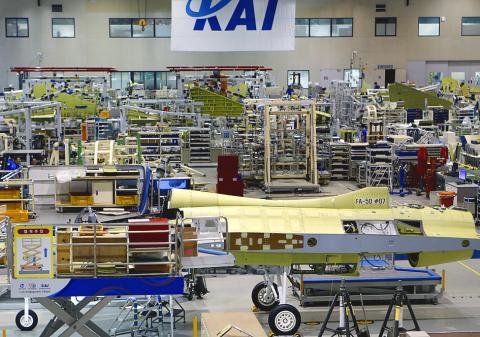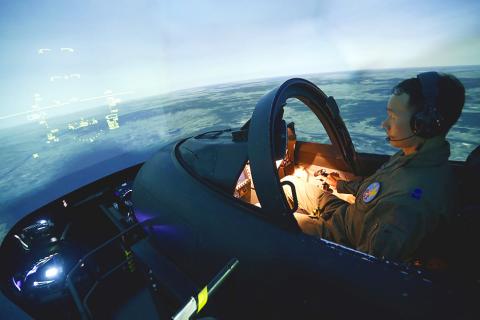South Korea, renowned for making high-tech consumer devices, cars and ships, now has its sights on exporting fighter jets amid a projected sharp increase in demand for military weapons in Asia over the next decade.
Korea Aerospace Industries Ltd (KAI) on Tuesday rolled out the nation’s first home-built light fighter — the FA-50 — from its assembly plant in the southern city of Sacheon.
KAI officials say that they aim to sell about 1,000 FA-50s and T-50s overseas over the next three decades, and are eyeing markets in Southeast Asia, Eastern Europe and the Americas.

Photo: Reuters
“Countries in Southeast Asia and South America are finding FA-50s enormously attractive,” Park Jeong-soo, a senior official from KAI’s external affairs department, told reporters.
Global defense budgets are forecast to increase by 9.3 percent to US$1.65 trillion by 2021, according to analysts IHS Janes.
Defense budgets in the Asia-Pacific region are forecast to outstrip that in North America by 2021, up 35 percent from this year’s levels to US$501 billion, it added in its Balance of Trade report in June.

Photo: Reuters
That will pit South Korea’s fighters against US, European, Chinese and Russian companies in an increasingly crowded — yet still lucrative — market.
BUDGET CONSTRAINTS
South Korea is also planning to develop a much larger KF-X fighter with the help of US defense contractors, although that has been delayed by budgetary constraints.

Photo: Reuters
The first FA-50 is part of an order for 20 fighters by South Korea’s air force, which will use them to replace its aging Northrop F-5 fighters.
Negotiations are ongoing with the Philippines, with a local online news outlet reporting that a US$460 million deal with Manila for 12 FA-50s could be completed this month.
Officials at the Sacheon headquarters of KAI declined to comment due to the sensitivity of the matter.
KAI chief executive officer Ha Sung-yong said that while South Korea’s conventional export markets such as cars and shipbuilding faced tough competition, its aerospace industry should grow strongly.
“Now that KAI has established the groundwork with its own technology, it is necessary to grow the industry ... by contributing to the national military’s force integration and creating jobs and exports,” Ha said.
LOCKHEED
The FA-50 is based on the T-50 advanced jet trainer, which is already in service in South Korea and was developed together with US defense contractor Lockheed Martin.
The T-50 can also be fitted with weapons under its wings and used as a light attack aircraft. Indonesia was the first export customer with a 2011 order for 16 T-50s, and Iraq is in negotiations to buy 24.
KAI and Lockheed are gearing up for a lucrative US Air Force competition for at least 300 aircraft and maybe hundreds more worth several billion dollars, a deal that one South Korean officer called the “jackpot.”

COMPETITION: AMD, Intel and Qualcomm are unveiling new laptop and desktop parts in Las Vegas, arguing their technologies provide the best performance for AI workloads Advanced Micro Devices Inc (AMD), the second-biggest maker of computer processors, said its chips are to be used by Dell Technologies Inc for the first time in PCs sold to businesses. The chipmaker unveiled new processors it says would make AMD-based PCs the best at running artificial intelligence (AI) software. Dell has decided to use the chips in some of its computers aimed at business customers, AMD executives said at CES in Las Vegas on Monday. Dell’s embrace of AMD for corporate PCs — it already uses the chipmaker for consumer devices — is another blow for Intel Corp as the company

ADVANCED: Previously, Taiwanese chip companies were restricted from building overseas fabs with technology less than two generations behind domestic factories Taiwan Semiconductor Manufacturing Co (TSMC, 台積電), a major chip supplier to Nvidia Corp, would no longer be restricted from investing in next-generation 2-nanometer chip production in the US, the Ministry of Economic Affairs said yesterday. However, the ministry added that the world’s biggest contract chipmaker would not be making any reckless decisions, given the weight of its up to US$30 billion investment. To safeguard Taiwan’s chip technology advantages, the government has barred local chipmakers from making chips using more advanced technologies at their overseas factories, in China particularly. Chipmakers were previously only allowed to produce chips using less advanced technologies, specifically

MediaTek Inc (聯發科) yesterday said it is teaming up with Nvidia Corp to develop a new chip for artificial intelligence (AI) supercomputers that uses architecture licensed from Arm Holdings PLC. The new product is targeting AI researchers, data scientists and students rather than the mass PC market, the company said. The announcement comes as MediaTek makes efforts to add AI capabilities to its Dimensity chips for smartphones and tablets, Genio family for the Internet of Things devices, Pentonic series of smart TVs, Kompanio line of Arm-based Chromebooks, along with the Dimensity auto platform for vehicles. MeidaTek, the world’s largest chip designer for smartphones

TECH PULL: Electronics heavyweights also attracted strong buying ahead of the CES, analysts said. Meanwhile, Asian markets were mixed amid Trump’s incoming presidency Taiwan Semiconductor Manufacturing Co (TSMC, 台積電) shares yesterday closed at a new high in the wake of a rally among tech stocks on Wall Street on Friday, moving the TAIEX sharply higher by more than 600 points. TSMC, the most heavily weighted stock in the TAIEX, rose 4.65 percent to close at a new high of NT$1,125, boosting its market value to NT$29.17 trillion (US$888 billion) and contributing about 400 points to the TAIEX’s rise. The TAIEX ended up 639.41 points, or 2.79 percent, at 23,547.71. Turnover totaled NT$406.478 billion, Taiwan Stock Exchange data showed. The surge in TSMC follows a positive performance